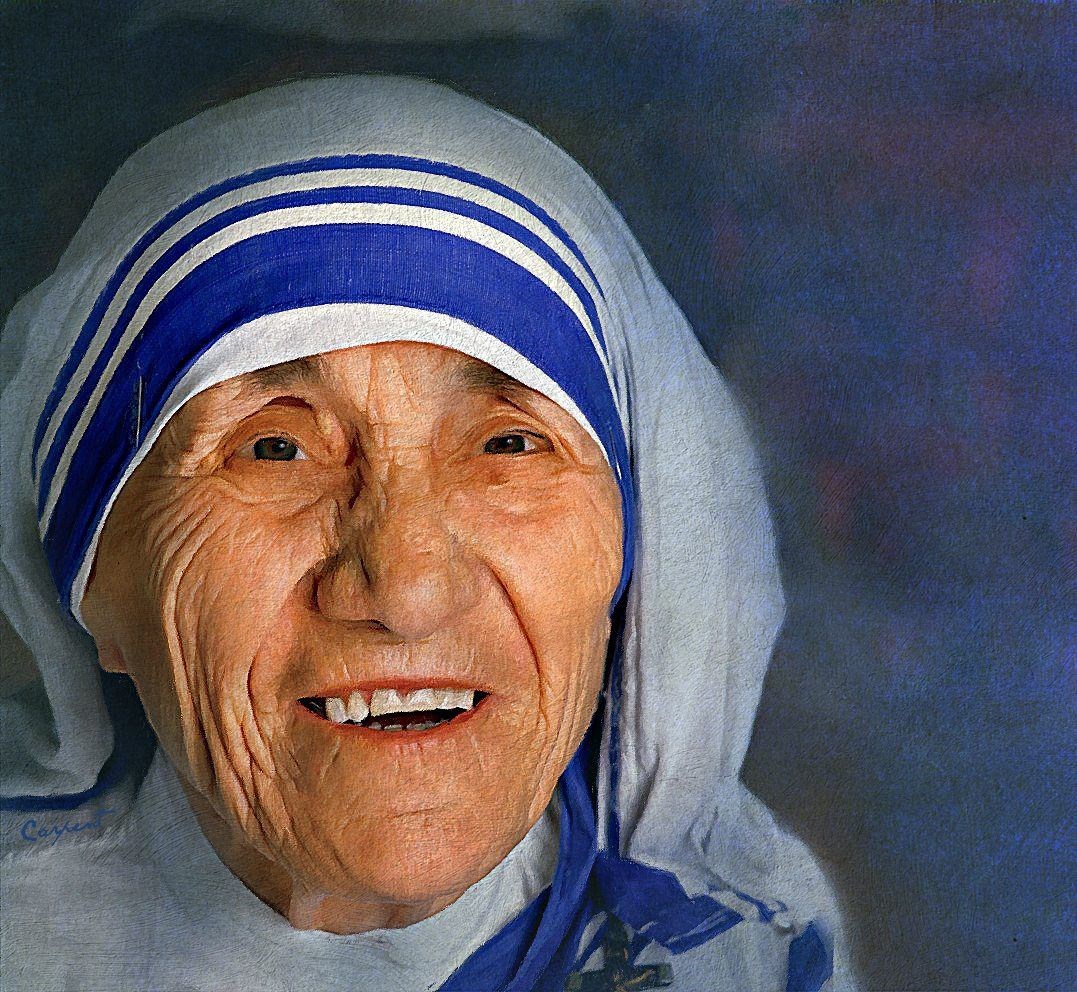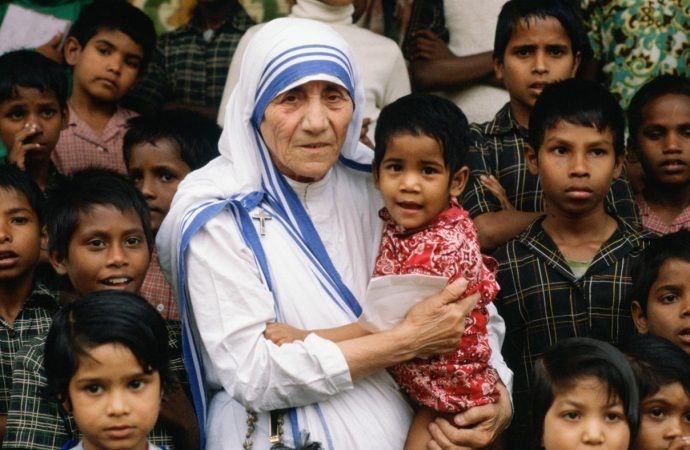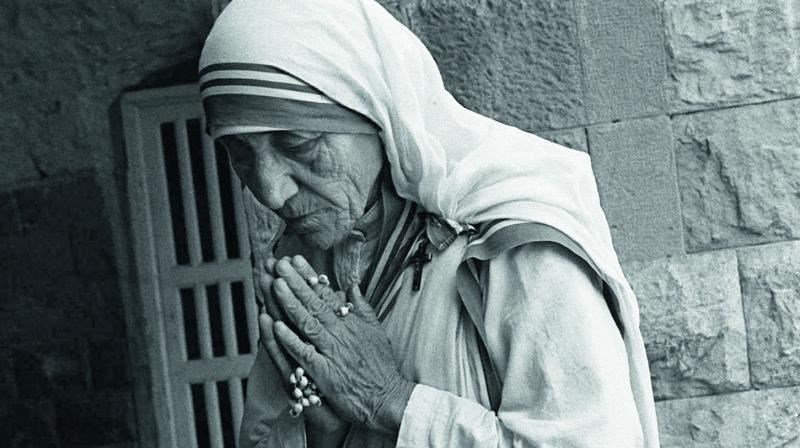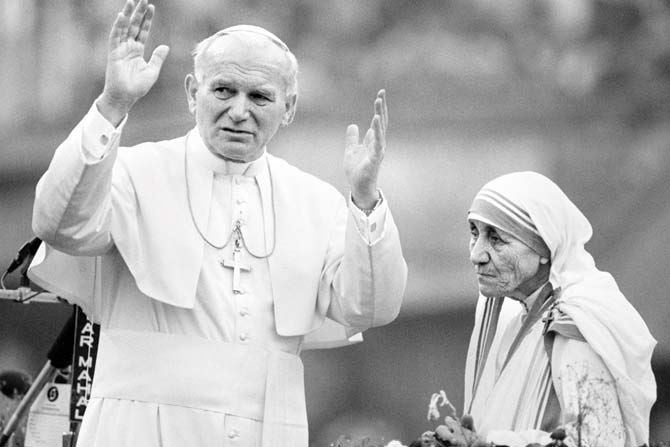Karina Millican
Mrs. Christopher
HHSE2: Period 3
1 May, 2018
A Heroic Saint
“The superhero-more than even the ordinary fictional hero-has to represent the values of the society that produces him” (Fleming 2). As expressed by Fleming in the article: “Review of Superman on the Couch: What Superheroes Tell Us about Ourselves and Our Society,” heroes are a representation of society’s morals and values. In society today, the definition of a hero is ambiguous. In modern times, our new superheroes are celebrities, idolized solely upon their popularity, physical appearance, and wealth; as opposed to their personality, notable achievements, or altruistic actions. However, there are discernable characteristics that illustrate the idea of a real hero. A person who puts others before himself shows selflessness. A person who devotes himself to helping others exemplifies compassion. A person who does not give up and continues to rise above challenges depicts perseverance. Heroes serve as valuable role models because they inspire and guide humankind to act on the values that they represent in society. Heroism is found in a girl giving her lunch money to a hungry peer, a doctor finding the cure for lung cancer, or a soccer player scoring a goal despite her injury. Each one of these people’s actions, no matter how big or small, represent values cherished by society: selflessness, compassion, and perseverance. Personally, a hero worthy of recognition is someone who inspires a positive change in the world through not only his words but also his actions.
 Mother Teresahttps://rationalfaiths.com/letter-mother-teresa/No one would have imagined that a petite, five-foot-tall woman would make an impact on society or later become Saint Mother Teresa of Calcutta through her selfless, compassionate acts and relentless perseverance. Mother Teresa, originally Bojaxhiu Agnes Gonxha was born in Skopje, Albania on August 27, 1910. She was born into a close-knit family consisting of her brother Lazar, her sister Agnes, her mother Dranafile, and her father, Nikola. Dranafile was a devout Catholic who helped charity often and consequently raised her children to do the same. When Mother Teresa was nine, she faced her first hardship, the loss of her father. However, this leads her to grow a closer relationship with God. When she was twelve, she realized her calling to help the poor. A few years later she joined a convent and became a nun at the age of 18 dedicating her life to serving God and the poor. In 1950, she founded the Missionaries of Charity to carry further out her mission of helping the ‘poorest of the poor.’ In 1979, she won the Nobel Peace Prize “for work undertaken in the struggle to overcome poverty and distress, which also constitutes a threat to peace.” After her death in 1997, she became a saint because of the model of holiness and service she exemplified throughout her life. A “true” hero, is one who is worthy of recognition must possess the selflessness and compassion to help others and the perseverance to overcome hardship. Mother Teresa embodies the idealistic nature of a real hero because of her selfless personality for putting not only God, but also commoners before herself, her compassion for aiding the less fortunate, and her perseverance for overcoming hindrances.
Mother Teresahttps://rationalfaiths.com/letter-mother-teresa/No one would have imagined that a petite, five-foot-tall woman would make an impact on society or later become Saint Mother Teresa of Calcutta through her selfless, compassionate acts and relentless perseverance. Mother Teresa, originally Bojaxhiu Agnes Gonxha was born in Skopje, Albania on August 27, 1910. She was born into a close-knit family consisting of her brother Lazar, her sister Agnes, her mother Dranafile, and her father, Nikola. Dranafile was a devout Catholic who helped charity often and consequently raised her children to do the same. When Mother Teresa was nine, she faced her first hardship, the loss of her father. However, this leads her to grow a closer relationship with God. When she was twelve, she realized her calling to help the poor. A few years later she joined a convent and became a nun at the age of 18 dedicating her life to serving God and the poor. In 1950, she founded the Missionaries of Charity to carry further out her mission of helping the ‘poorest of the poor.’ In 1979, she won the Nobel Peace Prize “for work undertaken in the struggle to overcome poverty and distress, which also constitutes a threat to peace.” After her death in 1997, she became a saint because of the model of holiness and service she exemplified throughout her life. A “true” hero, is one who is worthy of recognition must possess the selflessness and compassion to help others and the perseverance to overcome hardship. Mother Teresa embodies the idealistic nature of a real hero because of her selfless personality for putting not only God, but also commoners before herself, her compassion for aiding the less fortunate, and her perseverance for overcoming hindrances.
 Mother Teresa is pictured with "the poorest of the poor".https://cruxnow.com/analysis/2016/08/28/three-reasons-mother-teresas-halo-matters/ (Tim Graham/Contributor/ Hulton Archive/Getty Images.)Mother Teresa displayed selflessness and compassion through her sacrifices of worldly pleasures and dedication for aiding the poor. Mother Teresa’s selfless character reflected through her sacrifice in serving the less fortunate: “Another journalist who visited her in Calcutta found that her accommodations consisted of a small room furnished with single bed, a simple wooden table and a bucket for washing herself. Despite temperatures as high as 113°, there was not even a small fan. Indeed, there was only one small fan in the whole building, reserved for guests”(Commire). This imagery shows Mother Teresa’s simple, humble lifestyle. The phrase, “one small fan reserved for guests” reflects that even in her own home she still put others before herself. She sacrificed materialistic possessions to eliminate distractions so that she could focus on helping the “poorest of the poor.” As she said, “Live simply so others may simply live.” Her sacrifice shows her willingness to serve others and put others needs before her own. Supplementally, Mother Teresa’s altruistic personality is evident in her ability to live humbly to understand the hardships of the people she serves. Because of her giving the heart to help everyone she came in contact with, she impacted the lives of many. Her compassion for helping all people led her to inspire others to do the same: “Whether working with lepers, attending the dying, or feeding the poor, Mother Teresa’s instructions to her coworkers were always the same: ‘When you attend to the wounds and bruises of the poor, never forget that they are Christ’s wounds.’ She has always insisted that she can do the work because she is ministering to Jesus Christ himself ”(Commire). Mother Teresa compares the “wounds and bruises of the poor” to the wounds of Christ showing that she treated all people equally because she believed this was a right. She compares her passion for helping the poor to her passion for serving God. Her compassion for God and others showcased her real commitment to serving others. Mother Teresa eradicated all judgment of others to treat everyone with the same respect and attention she would give to God. Her dedication and sacrifice to serve others Her benevolence and dedication acted as a driving force for her perseverance, making her a hero above all else.
Mother Teresa is pictured with "the poorest of the poor".https://cruxnow.com/analysis/2016/08/28/three-reasons-mother-teresas-halo-matters/ (Tim Graham/Contributor/ Hulton Archive/Getty Images.)Mother Teresa displayed selflessness and compassion through her sacrifices of worldly pleasures and dedication for aiding the poor. Mother Teresa’s selfless character reflected through her sacrifice in serving the less fortunate: “Another journalist who visited her in Calcutta found that her accommodations consisted of a small room furnished with single bed, a simple wooden table and a bucket for washing herself. Despite temperatures as high as 113°, there was not even a small fan. Indeed, there was only one small fan in the whole building, reserved for guests”(Commire). This imagery shows Mother Teresa’s simple, humble lifestyle. The phrase, “one small fan reserved for guests” reflects that even in her own home she still put others before herself. She sacrificed materialistic possessions to eliminate distractions so that she could focus on helping the “poorest of the poor.” As she said, “Live simply so others may simply live.” Her sacrifice shows her willingness to serve others and put others needs before her own. Supplementally, Mother Teresa’s altruistic personality is evident in her ability to live humbly to understand the hardships of the people she serves. Because of her giving the heart to help everyone she came in contact with, she impacted the lives of many. Her compassion for helping all people led her to inspire others to do the same: “Whether working with lepers, attending the dying, or feeding the poor, Mother Teresa’s instructions to her coworkers were always the same: ‘When you attend to the wounds and bruises of the poor, never forget that they are Christ’s wounds.’ She has always insisted that she can do the work because she is ministering to Jesus Christ himself ”(Commire). Mother Teresa compares the “wounds and bruises of the poor” to the wounds of Christ showing that she treated all people equally because she believed this was a right. She compares her passion for helping the poor to her passion for serving God. Her compassion for God and others showcased her real commitment to serving others. Mother Teresa eradicated all judgment of others to treat everyone with the same respect and attention she would give to God. Her dedication and sacrifice to serve others Her benevolence and dedication acted as a driving force for her perseverance, making her a hero above all else.
 Mother Teresa praying outside the Missionaries of Charity.https://deccanchronicle.com/opinion/op-ed/020916/mother-teresa-the-making-of-a-saint.htmlMother Teresa manifests perseverance by overcoming setbacks with authorities and God. Mother Teresa experienced many roadblocks throughout her journey to spread peace and help the poor. One of those roadblocks occurred at the very beginning of her trip when she was sick and trying to become a nun: “On Sept. 10, 1946,...The local Archbishop, Ferdinand Périer, was initially skeptical (of giving his permission for Mother Teresa to become a nun)...on Jan. 6, 1948, Périer, after consulting the Vatican, finally permitted for Teresa to embark on her second calling”(Time Magazine). When Mother Teresa received her second calling from God, the archbishop denied her permission to go to Calcutta to carry out this calling because of her health. However, she did not let this incident stop her, for two years she persevered and persisted into convincing him to let her go. Mother Teresa did not let her health or the doubts of her authorities cloud her goal. Mother Teresa surmounted this impediment and continued to pursue her career of service. Three months before receiving the Nobel Peace Prize, she wrote this in her journal: “[But] as for me, the silence and the emptiness are so great, that I look and do not see,--Listen and do not hear--the tongue moves [in prayer] but does not speak ... I want you to pray for me--that I let Him have [a] free hand” (Time Magazine). This quote shows that she was struggling in her faith. Mother Teresa was a model of faith to many and thus many expected her to have the ideal relationship with God. The phrase, “the silence and emptiness is so great, that I look and do not see...” hints that she was wandering away from God and feeling a sense of abandonment. However, despite this rough patch in her faith, she continued her unwavering belief in the Lord. Mother Teresa’s ability to maintain a positive perspective and prevail over obstacles demonstrates characteristics of a real hero.
Mother Teresa praying outside the Missionaries of Charity.https://deccanchronicle.com/opinion/op-ed/020916/mother-teresa-the-making-of-a-saint.htmlMother Teresa manifests perseverance by overcoming setbacks with authorities and God. Mother Teresa experienced many roadblocks throughout her journey to spread peace and help the poor. One of those roadblocks occurred at the very beginning of her trip when she was sick and trying to become a nun: “On Sept. 10, 1946,...The local Archbishop, Ferdinand Périer, was initially skeptical (of giving his permission for Mother Teresa to become a nun)...on Jan. 6, 1948, Périer, after consulting the Vatican, finally permitted for Teresa to embark on her second calling”(Time Magazine). When Mother Teresa received her second calling from God, the archbishop denied her permission to go to Calcutta to carry out this calling because of her health. However, she did not let this incident stop her, for two years she persevered and persisted into convincing him to let her go. Mother Teresa did not let her health or the doubts of her authorities cloud her goal. Mother Teresa surmounted this impediment and continued to pursue her career of service. Three months before receiving the Nobel Peace Prize, she wrote this in her journal: “[But] as for me, the silence and the emptiness are so great, that I look and do not see,--Listen and do not hear--the tongue moves [in prayer] but does not speak ... I want you to pray for me--that I let Him have [a] free hand” (Time Magazine). This quote shows that she was struggling in her faith. Mother Teresa was a model of faith to many and thus many expected her to have the ideal relationship with God. The phrase, “the silence and emptiness is so great, that I look and do not see...” hints that she was wandering away from God and feeling a sense of abandonment. However, despite this rough patch in her faith, she continued her unwavering belief in the Lord. Mother Teresa’s ability to maintain a positive perspective and prevail over obstacles demonstrates characteristics of a real hero.
 Mother Teresa with Pope John Paul Ⅱ. https://www.mid-day.com/articles/sainthood-for-mother-teresa-next-year/16786152Mother Teresa’s selfless acts of compassion for others and endless perseverance exemplify the values of a real hero. Mother Teresa showed the world the effects of putting this quote into action: “Not all of us can do great things. But we can do small things with great love.” This quote displays Mother Teresa’s hope and enthusiasm that everyone can make a difference. She displayed compassion and love through her humanitarian efforts. Her selfless character reflected through her sacrifice and dedication to serving the “poorest of the poor.” Mother Teresa demonstrated perseverance in overcoming adversity and hardship to continue her mission. Her small actions towards others rippled a positive effect on the world, ultimately contributing to making the world a better place. As Malcolm Muggeridge so wonderfully put it, “It will be for posterity to decide whether she is a saint. I only say of her that in a dark time she is a burning and a shining light; in a brutal time, a living embodiment of Christ's gospel of love; in a godless time, the Word dwelling among us, full of grace and truth. For this, all who have the inestimable privilege of knowing her, or knowing of her, must be eternally grateful” (Commire). Muggeridge describes the legacy Mother Teresa left on all who were privileged to have met or known of her. She left a mark on this world for her compassion and dedication in selflessly serving so many with her actions. She embodies all the qualities a saint and hero possess. Furthermore, Mother Teresa is a model of the Catholic faith because of her fulfillment to serve out her calling just as any Catholic should. She is the perfect model for Catholics because her actions reflected the real virtues of the Catholic Church: to love and serve one another as Christ did. Mother Teresa is a prime example of just that and is therefore the reason why I look up to her as a role model in my faith and life. Since I first learned about her in fourth grade, I have continued to look to her as an example and draw to her selfless actions in aiding the poor and her compassion for her faith to guide me in life. The impact of her story compelled me to choose her as my saint for Confirmation. Mother Teresa has invoked a passion in me to help others so much that I am considering pursuing a career in the medical field (biomedical engineer or a surgeon). Ultimately, Mother Teresa encompassed the good of society and represented the values admired by society: selflessness, compassion, and perseverance. Mother Teresa not only continues to inspire me, but she also continues to inspire the world as an example of how actions of selflessness, compassion, and perseverance can make a change in the world.
Mother Teresa with Pope John Paul Ⅱ. https://www.mid-day.com/articles/sainthood-for-mother-teresa-next-year/16786152Mother Teresa’s selfless acts of compassion for others and endless perseverance exemplify the values of a real hero. Mother Teresa showed the world the effects of putting this quote into action: “Not all of us can do great things. But we can do small things with great love.” This quote displays Mother Teresa’s hope and enthusiasm that everyone can make a difference. She displayed compassion and love through her humanitarian efforts. Her selfless character reflected through her sacrifice and dedication to serving the “poorest of the poor.” Mother Teresa demonstrated perseverance in overcoming adversity and hardship to continue her mission. Her small actions towards others rippled a positive effect on the world, ultimately contributing to making the world a better place. As Malcolm Muggeridge so wonderfully put it, “It will be for posterity to decide whether she is a saint. I only say of her that in a dark time she is a burning and a shining light; in a brutal time, a living embodiment of Christ's gospel of love; in a godless time, the Word dwelling among us, full of grace and truth. For this, all who have the inestimable privilege of knowing her, or knowing of her, must be eternally grateful” (Commire). Muggeridge describes the legacy Mother Teresa left on all who were privileged to have met or known of her. She left a mark on this world for her compassion and dedication in selflessly serving so many with her actions. She embodies all the qualities a saint and hero possess. Furthermore, Mother Teresa is a model of the Catholic faith because of her fulfillment to serve out her calling just as any Catholic should. She is the perfect model for Catholics because her actions reflected the real virtues of the Catholic Church: to love and serve one another as Christ did. Mother Teresa is a prime example of just that and is therefore the reason why I look up to her as a role model in my faith and life. Since I first learned about her in fourth grade, I have continued to look to her as an example and draw to her selfless actions in aiding the poor and her compassion for her faith to guide me in life. The impact of her story compelled me to choose her as my saint for Confirmation. Mother Teresa has invoked a passion in me to help others so much that I am considering pursuing a career in the medical field (biomedical engineer or a surgeon). Ultimately, Mother Teresa encompassed the good of society and represented the values admired by society: selflessness, compassion, and perseverance. Mother Teresa not only continues to inspire me, but she also continues to inspire the world as an example of how actions of selflessness, compassion, and perseverance can make a change in the world.
Page created on 5/29/2018 1:19:18 AM
Last edited 6/1/2018 6:33:08 PM
